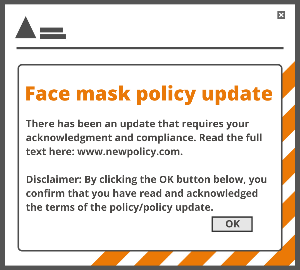
Having effective internal communications practices in place helps to ensure that your employees are all working together towards achieving common goals.
You might wonder why internal communication is important. It has real benefits for productivity and profits and helps boost engagement and morale so that your company can retain the best staff. That is why it is crucial to improve internal communications.
Research from Towers Watson has revealed that organizations that are good at communicating internally are almost twice as likely to outperform their competitors financially.
Unfortunately, many companies are falling behind in the internal communications space and aren’t unlocking their potential.
A Gallup study found that just 41% of American employees felt that they understood what their company stands for and how it is different from its competitors.
And a study by Arthur J. Gallagher and Co found that 60% of companies haven’t got a long-term internal communication strategy in place.
Keeping employees connected is even more challenging during the COVID-19 pandemic, with employees working remotely. But, organizations put many measures in place aimed at improving internal communications in the workplace to ensure their employees are informed and up-to-date, no matter where they work.
Table of contents
29 ways to improve internal communications in the workplace
How to improve internal communication in a company with DeskAlerts
29 ways to improve internal communications in the workplace
Whether your company doesn’t communicate internally at all, or if it does communicate but doesn’t make it a priority, this is how to improve internal communication in an organization:
1. Develop an internal communications strategy
A Gatehouse Study found that only 21% of internal communicators have a formal plan.
Having an internal communication strategy in place will help to guide you in your internal communications efforts. It sets out your goals and objectives, key messages, communication methods and channels that will be used and who will be responsible for delivering the information, which is the most important foundation you can have to improve internal communication in the workplace.
2. Communicate regularly
Regular communication helps to build trust. Without communication, there is a lack of direction and misinformation and rumors can take root, spread and fester. This has flow-on effects on productivity, morale, and even how your employees interact with your customers.
However, this doesn’t mean that you should just send constant messages. It’s important to prioritize quality above quantity because too much information can have consequences as well, such as information overload.

3. Develop a content strategy
Having a strategy that you prepare in advance helps to keep you focused and takes the pressure off when it comes to developing content. You might not know everything that you will need to communicate throughout the year – after all, things do happen that aren’t anticipated – but it can serve as a guide to tell the stories you want to tell that are important to your company.
A report from the Content Marketing Institute found that 68% of people who use a content strategy found that it helps them to achieve the desired communication results.
4. Develop engaging content
There’s no point sending out information to employees that is presented in a bland, boring way. If you want the information to be retained, the content needs to be high-quality and engaging. This means that you need to produce it with the end-user in mind whether you write something or show images or videos.
There should be some value to the employee in the content that is being delivered to them. In many cases, there should be a call to action, such as what you need them to do (eg, fill in a survey, modify their behavior, participate in training etc.)
>> Examples of visual communication in the workplace <<
5. Communicate clearly and concisely
Not only should your communications be engaging, but they need to be professionally written with correct spelling and grammar, be written in plain language that avoids unnecessary jargon, and be as concise as possible.
Brevity is also important: busy people don’t have a lot of time to spend wading through documents to determine what is important and what they need to know.
A Siemens Enterprise Communications report found that around 17 hours of each workweek in mid-sized companies is spent clarifying misunderstandings!
6. Use different channels to communicate
People want to hear from their employers, but do they?
Gallup research reveals that 74% of employees feel that they are missing out on receiving important information at work.
A multi-channel approach to internal communication is one of the best examples of how to improve company communication in today’s digital age. You can’t just send an email and expect that you will get the results you need. In order to ensure your messages can cut through and reach the intended audience, you need to deliver them across different channels that are available to you in order to reach people.
7. Provide opportunities for two-way feedback
Best practice internal communication in organizations involves establishing two-way dialogues. Employees want to be able to contribute feedback and ensure that their opinions, recommendations, and questions are heard. You can do this in many ways, such as surveys, anonymous feedback forms, workshops, focus groups, and Town Hall consultations.
A Salesforce survey found that when employees feel that they are listened to in the workplace, they’re around five times more likely to feel empowered to do their best possible work.
8. Ensuring your leadership team supports internal communications
If you want to embed any kind of change in your company, it won’t succeed unless your leadership team is on board with it… and this includes better internal communications. Leaders often don’t realize, that good internal communications are more than just a KPI… and it shows.
A survey by Webster Shandwick found that only 32% of employees felt that their company’s top leaders were communicating effectively.
You need to show your leadership team how to improve internal communication in your organization and get them to commit to communicating regularly and authentically and ensure that they are listening to their employees.
9. Select internal communications champions from across the organization
A good way to improve company communication is to have champions in different work teams who can encourage their teams to communicate well within the team and others outside of the team.
10. Have systems for urgent communications
Don’t be caught out if there is an emergency or any other type of crisis or urgent situation where you need to contact employees quickly, in a highly visible way. Having an emergency communication system that is fit-for-purpose will ensure that you can reach your employees fast when it is critical to do so.
11. Understand your audience
Who are the people who work for you? There are many different demographics within any organization… and as with all demographics, they will have different communications needs and preferences.
This can include different generations in the workforce, different occupational groups, people who are based in different geographic locations, specific work teams, and levels of seniority (creating the documents called “workplace persona” can help).
Understanding who your intended audience is will help you to develop and deliver content to them more effectively.
12. Schedule your content ahead of time
“Content batching” is the term used to refer to creating and scheduling content in advance in order to save time. Setting aside time and writing and scheduling a lot of content at once can free up time to do other things.

13. Tell stories
Corporate storytelling is an art form in itself, but it can help to get your message across. When you present something as a story – whether it’s an anecdote or you’re profiling a real person and the work they do – you are more likely to resonate with your audience.
Researchers Dan and Chip Heath found that 63% of people who have seen a presentation are more likely to remember a story compared to 5% who will remember statistics that they heard in the presentation.
14. Encourage open and honest dialogues
Employees want to be heard, they want to know that it is safe to speak up and give their opinion and that they can trust the information coming to them from their employer.
Salesforce research has found that 90% of employees want to work for an employer who discusses issues efficiently and inclusively and includes them in the decision-making process – however, only 40% believe that this happens in their organization.
15. Ensure it is easy for people to find information
Intranets and network file systems make it very difficult for people to find the information they need when they need it. They are often a dumping ground for documents that are hard to locate or are outdated.
Research from M-Files has found that 46% of employees feel that finding the documents they need to do their jobs can be time-consuming and challenging, and 83% have recreated documents that already exist because they couldn’t locate them on the corporate network!
16. Break down internal silos
A common problem in many organizations is that different work teams don’t communicate with other teams. This can mean that important information isn’t shared, and there may even be duplication in work.
A Queens University of Charlotte research found 39% of employees feel that there isn’t enough collaboration between teams within their organizations.
Having opportunities for teams to get to know one another and collaborate can help to break these silos down.
17. Make better internal communication part of your company culture
It’s more than just communicating between teams, though. Communication needs to be thoroughly embedded in a company’s culture in order to thrive.
A McKinsey Global Institute study found that there is a 20-25% increase in productivity in companies that establish better connections between their employees.
This means you need to have managers communicating with employees, employees communicating with their peers and employees communicating with managers.
18. Establish reward and recognition programs
Does your organization reward and recognize excellence and effort?
A Globoforce study found that 69% of employees will work harder if they feel that they are getting feedback and recognition for their work.
This also helps employees get to know about other people in the organization and the work that they are doing.
19. Have a consistent onboarding process
First impressions count… especially when it is a new employee starting with a new company. In many organizations, they are inducted and onboarded in an ad-hoc fashion and whether that is successful will depend on how strong their manager is at communicating important information.
You guessed it: this can vary wildly, and the result is an inconsistent onboarding process where new recruits aren’t always empowered with the tools and knowledge they need to succeed.
Developing a consistent process that any manager can use will help to establish a level playing field.
20. Always share your important news with employees
If something big happens in your company – good or bad – you need to tell your employees first before hearing it from the outside world! By not prioritizing them, you are sending a message that they aren’t necessary.
Depending on the nature of the information, your employees may also be resentful if they find out about it from a second-hand source.
21. Use an employee app
Even before the COVID-19 pandemic, most workers around the world weren’t sitting at desks all day.
According to the 2018 Deskless Workers Report, it was estimated around 80% of workers are deskless.
This includes, but is not limited to, a diverse range of sectors, including healthcare, transport and logistics, construction, mining, technical trades, sales, retail, hospitality, agriculture, manufacturing and more.
With the pandemic, many traditional office workers are now working remotely from home. Having an employee communications app is one of the best ways to improve internal communication in an organization and ensure that you reach all your employees with a smartphone quickly and easily. They don’t need to rely on being on a computer to receive important company communications.
22. Encourage regular dialogues between managers and their teams
As part of a good culture of communications, it’s important that managers communicate with their teams regularly and share important information.
An Interact/Harris poll found that 91% of employees thought their managers lacked communication skills.
23. Let the CEO meet and listen to employees
If your CEO is removed from employees all the time and has little-to-no interaction with them, it will be hard for employees to relate to the CEO and vice versa. There are lots of ways your CEO can meet people (town halls, focus groups, meet and greet sessions, social functions, visiting individual work teams or sites, etc.)
24. Celebrate successes
A good way to bring people together is by celebrating success: whether that’s a milestone, an anniversary or amazing results for the company, let your people share in the glory!
25. Learn from your own experiences
What has worked well in the past for internal communication in your company? What didn’t work? If you haven’t been with the organization for a long time, talk to employees who have been so that you can gather the information that sees you replicate successes or avoid things that didn’t work.
26. Use social media
People are used to using social media in their personal lives and find it an easy and efficient way to communicate with family, friends and acquaintances. There are ways to incorporate social tools in your internal communications, including in your intranet, to provide a similar experience and method of interaction with others in the workplace that employees are comfortable with using.
27. Start having ‘stay interviews’
You might use ‘exit interviews’ in your organization as a way of gathering feedback from departing employees about why they are going. A ‘stay interview’ is a concept where managers have one-on-one meetings with their employees to find out what is working for them and what isn’t in terms of their satisfaction with the company. Not only does this improve internal communication, but can help you to identify any cultural issues in the workplace that need to be fixed. It will also help you to retain your best employees.
According to the Work Institute, stay interviews can help organizations predict whether or not employees will leave 20% more accurately.
28. Produce an internal newsletter
If you aren’t already creating and distributing internal newsletters, you should consider doing so. They are a good way to group a lot of information in one place without overloading employees with many different messages.
29. Evaluate your communications
No matter what steps you take to improve corporate communications in your company, it is important that you have a mechanism in place to evaluate your work. Without a proper system of evaluation, you will be operating in the dark and won’t know if your efforts have been successful or not.
How to improve internal communication in a company with DeskAlerts

When you’re considering tools to utilize in your internal communications efforts, you can’t look past DeskAlerts. It’s a powerful internal communications solution that can be used in multiple ways to keep your staff informed.
These are some of the key features you can trust to keep your employees up-to-date with important information:
Pop up alerts – ensure that messages can’t be skipped or ignored
 When you use DeskAlerts as your corporate notification system, messages are sent straight to your employees’ computers in the form of a pop-up window that can’t be skipped or ignored.
When you use DeskAlerts as your corporate notification system, messages are sent straight to your employees’ computers in the form of a pop-up window that can’t be skipped or ignored.
The pop-up alert will always be the top item on a screen, no matter what apps or software your staff are using – even if it is locked or in screensaver mode.
You can send rich content, including images, audio, video and HTML. The DeskAlerts corporate notification system comes with Windows and macOS support. You can customize your alerts to match your corporate branding and also create templates you can use in advance. The system will also confirm who has read the messages in real time.
Video alerts – use the power of visual communication
Video is proving to be an effective way of communicating internally in organizations. You can use DeskAlerts video alerts to send messages containing videos in an assortment of formats. They are sent to recipients as desktop pop-ups, just like any other DeskAlerts messages.
Emergency alerts – keep your employees safe in an emergency
DeskAlerts can be used as an emergency alert system, enabling you to send urgent information to your employees in an emergency or disaster situation.
You can send the emergency alerts to your entire workforce, or just those employees who are affected: for example, your office in one particular city, staff who work on a specific floor of an office building.
The user-friendly platform will minimize the time it takes you to send an emergency alert, which is essential during time-critical incidents. You can save even more time by sending a pre-defined message to a pre-defined audience.
Digital signage – create colorful internal billboards
The DeskAlerts Digital Signage solution helps you use LED, LCD, and projection displays to show the content of different formats such as videos, images, graphics and text. This is a good way to reinforce the information in your internal communications campaigns and share information, corporate news and product and service promotions to employees inside the office and clients in your public areas.
Desktop ticker – send scrolling text to screens
The desktop ticker is a less intrusive and interruptive method of relaying messages. It’s a narrow window that scrolls moving text at the bottom of your employees’ computer screens. It can be used to send news, article follow-ups and updates, and links to internal communications resources such as SharePoint and intranet sites.
Corporate wallpaper, screensaver and lock screen – make the most of your operating system’s features for communication
These are more passive solutions, letting you communicate with employees directly to their computers. Your materials will appear in the background of their computers as wallpaper or on their screensaver when their machines enter screensaver mode – or you can do both.
Surveys, polls and quizzes – instantly find out what your employees think
When you want feedback from employees or you want to test their knowledge, the surveys, polls and quizzes module will give you the results that you need in real time. This is a great way to send internal communications surveys, pulse surveys or even just to conduct a mini poll.
***
Internal communications help just about every aspect of your business, from business results and financial performance to make your workplace a pleasant one for your employees. You have everything to gain and nothing to lose from improving internal communications in the workplace… why wait any longer?
Get in touch with us today to find out how DeskAlerts can change your business.
FAQ
What is internal communication?
Internal communication is the term used to describe the way that information is shared within a company. This can include management communicating with employees, as well as the way that different departments communicate with the rest of the organization, the way teams communicate and the ways that employees can communicate with management.
How can internal communication be improved in the workplace?
Internal communication in the workplace can be improved by implementing a strategy that describes who you will communicate with, what you will say, how often you will communicate, when you will communicate, and what channels you will use to communicate. Performing quantitative and qualitative analysis of your communications can help you determine if it was effective so you can refine your methods and make improvements in the future.
How can employee communication be improved?
Employee communication can be improved by sending relevant and timely information to your staff members that help them to do their jobs and contribute proactively to your company’s overall success. This involves using a range of communications channels that provide for the effective and efficient distribution of important information.
 Caroline Duncan
Caroline Duncan




 When you use DeskAlerts as your corporate notification system, messages are sent straight to your employees’ computers in the form of a pop-up window that can’t be skipped or ignored.
When you use DeskAlerts as your corporate notification system, messages are sent straight to your employees’ computers in the form of a pop-up window that can’t be skipped or ignored.




